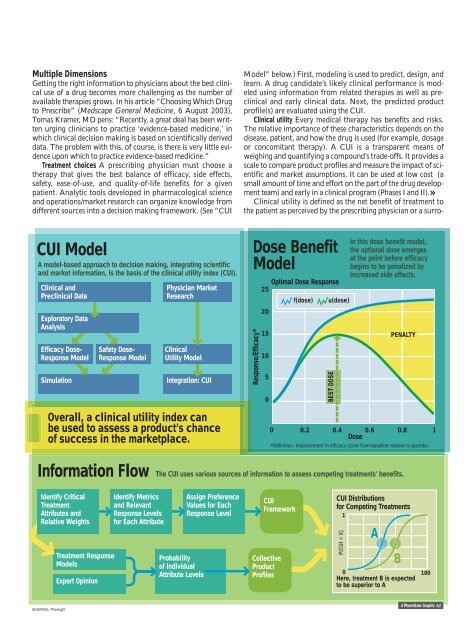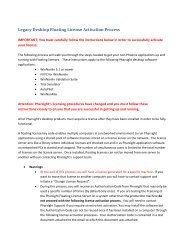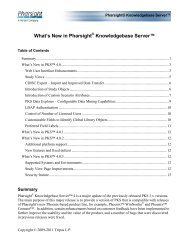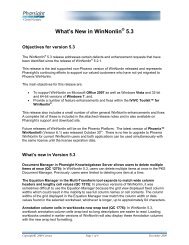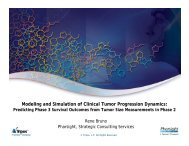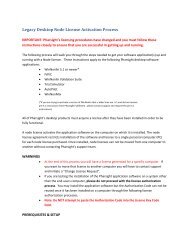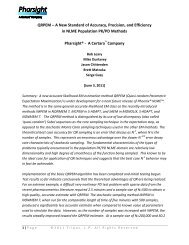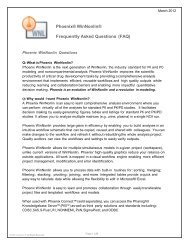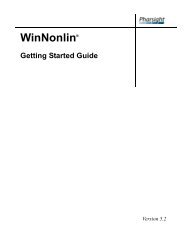A clinical utility index (CUI) openly evaluates a product's attributes ...
A clinical utility index (CUI) openly evaluates a product's attributes ...
A clinical utility index (CUI) openly evaluates a product's attributes ...
You also want an ePaper? Increase the reach of your titles
YUMPU automatically turns print PDFs into web optimized ePapers that Google loves.
Multiple Dimensions<br />
Getting the right information to physicians about the best <strong>clinical</strong><br />
use of a drug becomes more challenging as the number of<br />
available therapies grows. In his article “Choosing Which Drug<br />
to Prescribe” (Medscape General Medicine, 6 August 2003),<br />
Tomas Kramer, MD pens: “Recently, a great deal has been written<br />
urging clinicians to practice ‘evidence-based medicine,’ in<br />
which <strong>clinical</strong> decision making is based on scientifically derived<br />
data. The problem with this, of course, is there is very little evidence<br />
upon which to practice evidence-based medicine.”<br />
Treatment choices A prescribing physician must choose a<br />
therapy that gives the best balance of efficacy, side effects,<br />
safety, ease-of-use, and quality-of-life benefits for a given<br />
patient. Analytic tools developed in pharmacological science<br />
and operations/market research can organize knowledge from<br />
different sources into a decision making framework. (See “<strong>CUI</strong><br />
Model” below.) First, modeling is used to predict, design, and<br />
learn. A drug candidate’s likely <strong>clinical</strong> performance is modeled<br />
using information from related therapies as well as pre<strong>clinical</strong><br />
and early <strong>clinical</strong> data. Next, the predicted product<br />
profile(s) are evaluated using the <strong>CUI</strong>.<br />
Clinical <strong>utility</strong> Every medical therapy has benefits and risks.<br />
The relative importance of these characteristics depends on the<br />
disease, patient, and how the drug is used (for example, dosage<br />
or concomitant therapy). A <strong>CUI</strong> is a transparent means of<br />
weighing and quantifying a compound’s trade-offs. It provides a<br />
scale to compare product profiles and measure the impact of scientific<br />
and market assumptions. It can be used at low cost (a<br />
small amount of time and effort on the part of the drug development<br />
team) and early in a <strong>clinical</strong> program (Phases I and II).»<br />
Clinical <strong>utility</strong> is defined as the net benefit of treatment to<br />
the patient as perceived by the prescribing physician or a surro-<br />
<strong>CUI</strong> Model<br />
A model-based approach to decision making, integrating scientific<br />
and market information, is the basis of the <strong>clinical</strong> <strong>utility</strong> <strong>index</strong> (<strong>CUI</strong>).<br />
Clinical and<br />
Pre<strong>clinical</strong> Data<br />
Exploratory Data<br />
Analysis<br />
Efficacy Dose-<br />
Response Model<br />
Simulation<br />
Safety Dose-<br />
Response Model<br />
Physician Market<br />
Research<br />
Clinical<br />
Utility Model<br />
Integration: <strong>CUI</strong><br />
Overall, a <strong>clinical</strong> <strong>utility</strong> <strong>index</strong> can<br />
be used to assess a product’s chance<br />
of success in the marketplace.<br />
Dose Benefit<br />
Model<br />
Response/Efficacy*<br />
Optimal Dose Response<br />
25<br />
f(dose) u(dose)<br />
20<br />
15<br />
10<br />
5<br />
0<br />
BEST DOSE<br />
In this dose benefit model,<br />
the optional dose emerges<br />
at the point before efficacy<br />
begins to be penalized by<br />
increased side effects.<br />
PENALTY<br />
0 0.2 0.4 0.6 0.8 1<br />
Dose<br />
*Definition: Improvement in efficacy score from baseline relative to placebo<br />
Information Flow<br />
The <strong>CUI</strong> uses various sources of information to assess competing treatments' benefits.<br />
Identify Critical<br />
Treatment<br />
Attributes and<br />
Relative Weights<br />
Treatment Response<br />
Models<br />
Expert Opinion<br />
Identify Metrics<br />
and Relevant<br />
Response Levels<br />
for Each Attribute<br />
Probability<br />
of Individual<br />
Attribute Levels<br />
Assign Preference<br />
Values for Each<br />
Response Level<br />
<strong>CUI</strong><br />
Framework<br />
Collective<br />
Product<br />
Profiles<br />
<strong>CUI</strong> Distributions<br />
for Competing Treatments<br />
1<br />
P(<strong>CUI</strong> < X)<br />
A<br />
B<br />
0 100<br />
Here, treatment B is expected<br />
to be superior to A<br />
SOURCES: Pharsight<br />
A PharmExec Graphic


